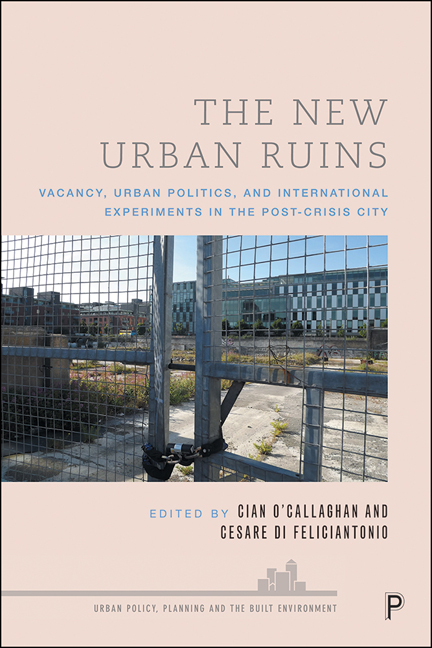Book contents
- Frontmatter
- Contents
- List of figures and tables
- Notes on contributors
- Acknowledgements
- Introduction
- PART I Rethinking ruination in the post-crisis context
- PART II The political economy of urban vacant space
- PART III Reappropriating urban vacant spaces
- Conclusion: Centring vacancy – towards a research agenda
- Index
7 - Post-disaster ruins: the old, the new and the temporary
Published online by Cambridge University Press: 13 May 2022
- Frontmatter
- Contents
- List of figures and tables
- Notes on contributors
- Acknowledgements
- Introduction
- PART I Rethinking ruination in the post-crisis context
- PART II The political economy of urban vacant space
- PART III Reappropriating urban vacant spaces
- Conclusion: Centring vacancy – towards a research agenda
- Index
Summary
Introduction
Structural housing vacancy and abandonment occur in many circumstances and are phenomena that generally happen when something disturbs the overall ‘equilibrium’ of a given area. Urban scholarship has often considered these forms of housing emptiness in relationship to processes of urban decline, suburbanisation, deindustrialisation, financial crises and the collapse of local housing markets (Keenan et al, 1999; Glock and Haussermann, 2004; O’Callaghan et al, 2018). Indeed, in certain contexts, processes of economic and social restructuring have led to declining or collapsing demand, resulting in housing underuse, disuse and eventual abandonment (Power and Mumford, 1999; Couch and Cocks, 2013; Wang and Immergluck, 2019). Far from being natural, these processes are often closely linked to the political economy of uneven development and to the action of discrete actors in the realms of the state, the real estate industry and finance (Coppola, 2019).
However, although there is a growing literature on housing emptiness associated with issues of spatial restructuring and urban shrinkage (see Gribat, this volume), its connections to natural disasters have been largely ignored. Disasters dramatically impact the stability of territories, resulting in places that are suddenly shut off and collapse socially and economically (Myers, 2002; Black et al, 2013; Drolet, 2015). Great natural disasters may exceed the ability of communities to recover, especially when pre-impact conditions make the emergency response and reconstruction difficult and costly. Indeed, the combination of damages and territories already experiencing forms of urban decline or contraction leads to longer-lasting socio-spatial impacts. In these cases, the territorial and social breakdown provoked by shocks is magnified, and processes of vacancy, abandonment and ruination occur on a very large scale, making public policy and governmental intervention both crucial and highly problematic. In fact, while housing oversupply can represent an opportunity for the setting up of post-emergency shelter and temporary housing operations (Comerio, 1997), over the long run, it will likely prove to be challenging in terms of reconstruction choices and long-term market viability.
Looking at the government response following the immediate shock, the main urgent issue is the mobilisation of variably defined temporary housing solutions to provide shelter to evacuees. In the meanwhile, the planning operations for the long-term recovery of the built environment are launched, based on highly localised governance conditions and arrangements, trans-scalar state relations and risk protection and compensation regimes.
- Type
- Chapter
- Information
- The New Urban RuinsVacancy, Urban Politics, and International Experiments in the Post-Crisis City, pp. 125 - 144Publisher: Bristol University PressPrint publication year: 2021



